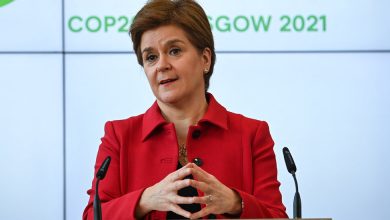
Eurozone Inflation Sets Another Record, Hitting 10 Percent in September
Consumer prices in the countries that use the euro as their currency rose at an annual rate of 10 percent in September, again reaching the highest level since the creation of the euro more than two decades ago, the European Commission reported on Friday.
The double-digit pace was a big jump from 9.1 percent in August, the previous record.
Energy prices, which rose at an annual rate of 40.8 percent in September, were again the main contributor to accelerating inflation in the eurozone, driven higher by the invasion of Ukraine by Russia, which previously supplied most of Europe’s natural gas. Food prices rose 11.8 percent in September, from 10.6 percent in August.
Of the 19 eurozone countries, 10 recorded double-digit overall inflation, including the largest economy, Germany, which released its own inflation result the day before — 10.9 percent. That was the highest rate of inflation that Germany had seen since 1951, well before the reunification of the former East and West.
Estonia, Lithuania and Latvia all registered inflation rates above 22 percent. The reason, said Beata Javorcik, the chief economist of the European Bank for Reconstruction and Development, is that the increase in wholesale energy prices has been reflected in retail prices paid by households. The Netherlands, at 17.1 percent in September, up from below 14 percent the previous month, and Slovakia, at 13.6 percent, were also in the unfortunate group of nations with higher-than-average rates.
In France, where the government has moved aggressively to cap energy prices, inflation eased a bit, dropping to 6.2 percent in September, from 6.6 percent the previous month. Energy inflation eased there, but food inflation increased. Still, thousands took to the streets across the country on Thursday to demand higher wages to cope with inflation.
“Inflation is also higher in non-energy industrial goods and services, in particular,” said Lucrezia Reichlin, an economics professor at the London Business School and a former head of research at the European Central Bank. “This is an indication that the energy shock is having a broader effect on all other items.”
Excluding food and energy, so-called core inflation rose 4.8 percent in the year through September, up from 4.3 percent the month before.
Ms. Reichlin added that there is still a lot of uncertainty about how inflation will develop in the coming months, “because the economy will slow down in the future and that will have downward pressure on inflation.”
Pantheon Macroeconomics noted that government policies designed to manage soaring energy costs will also be “a key swing factor” influencing energy prices over the next six months.
Inflation has been gnawing at living standards and savings not only in Europe but all over the world. Supply chain backlogs and disruptions stemming from the coronavirus pandemic, and the surge of activity that accompanied the reopening of economies, have pushed up prices. Soaring energy and food prices that followed Russia’s invasion of Ukraine also stoked inflation, with sanctions imposed by Europe, the United States and their allies turbocharging it.
The European Central Bank has been aggressively raising rates in hopes of halting inflation’s march across the eurozone. On Thursday, E.C.B. policymakers indicated that they are likely to approve another three-quarter-point interest rate increase at their next meeting, in late October.
The Federal Reserve’s determination to beat back inflation with higher interest rates has been nudging prices down in the United States, but pumping them up elsewhere. Anxiety about global political and economic has turmoil encouraged investors to put their money into American securities and assets because they are considered havens during times of upheaval. Elevated interest rates makes those investments even more attractive by offering bigger returns.
The result is that the United States is exporting some of its inflation to other countries. As the dollar strengthens, imports from around the world become cheaper in the United States, which helps to check inflation there. The flip side is that a strong dollar makes imports in other countries, particularly essential ones like energy and food, more expensive to buy with weaker currencies. The dollar is the world’s reserve currency and many key commodities, like oil, are priced in dollars.
Inflation across the European Union, which has 27 members, rose above a 10 percent annual pace already in August, with nations that do not use the euro also seeing the price of energy and food soar to record heights. In the Czech Republic, which has seen mass protests over the high cost of energy, inflation came in at more than 17 percent in August, roughly the same rate Poland recorded for September, which was a 25-year record.
In Britain, consumer prices rose 9.9 percent in August from a year earlier, down from 10.1 percent in the previous month, but still near the fastest pace in 40 years. Households and businesses in Britain are feeling the squeeze on their budgets, along with market turmoil this week stemming from the government’s new economic strategy that upended mortgages, pensions and the value of pound.
Several experts say that Europe’s transition away from Russian energy is a slow process and is likely to keep oil, gas and electricity prices at painful levels for years.
Sven Smit, a senior partner at the consulting firm McKinsey, said that when there is significant energy shortage that pushes up prices, there is only so much that central bankers can do about it. Higher interest rates cannot suddenly manufacture more supply, he said, so prices will remain high.




